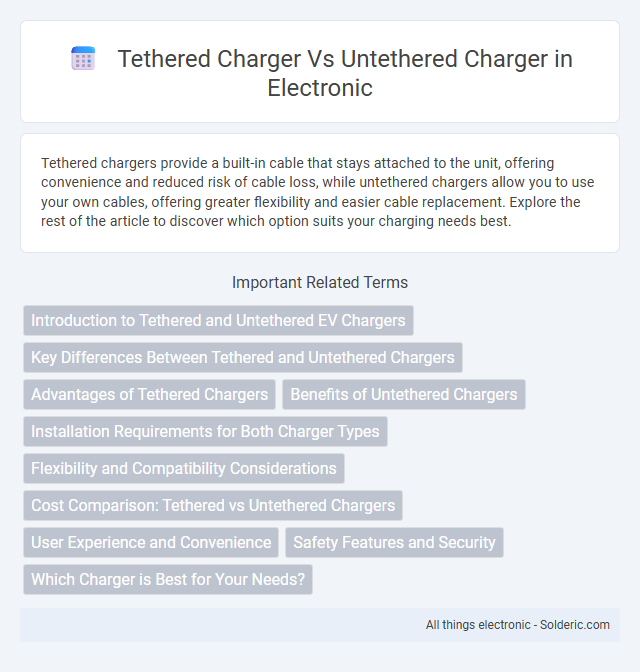Tethered chargers provide a built-in cable that stays attached to the unit, offering convenience and reduced risk of cable loss, while untethered chargers allow you to use your own cables, offering greater flexibility and easier cable replacement. Explore the rest of the article to discover which option suits your charging needs best.
Comparison Table
| Feature | Tethered Charger | Untethered Charger |
|---|---|---|
| Definition | Charger with an attached charging cable | Charger without an attached cable; requires separate cord |
| Portability | Less portable due to fixed cable | More portable; cable can be detached and stored separately |
| Convenience | Quick and easy connect without extra accessories | Requires carrying an additional charging cord |
| Durability | Cable prone to wear and damage over time | Cable can be replaced independently |
| Compatibility | Limited to specific connectors attached to charger | More flexible; can use various cables with same charger |
| Cost | Generally lower initial cost | Potentially higher cost due to separate cable purchase |
Introduction to Tethered and Untethered EV Chargers
Tethered EV chargers feature a permanently attached cable, providing a convenient and ready-to-use charging solution for electric vehicle owners. Untethered chargers come with a socket, requiring users to connect their own cable, offering greater flexibility and compatibility with various EV models. Both types support different power levels and installation environments, influencing user preference based on charging needs and vehicle compatibility.
Key Differences Between Tethered and Untethered Chargers
Tethered chargers feature a cable permanently attached to the charging unit, offering convenience for consistent use but limiting portability and cable replacement options. Untethered chargers provide flexibility with detachable cables, enabling easier transportation and the ability to use different cable types or lengths depending on user needs. The choice between tethered and untethered chargers impacts user experience, maintenance, and adaptability in various charging scenarios.
Advantages of Tethered Chargers
Tethered chargers offer the advantage of convenience by eliminating the need to carry separate cables, ensuring your device is always ready to charge. Their integrated design reduces the risk of losing or forgetting the charging cable, providing a faster and more reliable charging experience. You benefit from seamless usability, especially in public spaces or shared environments where the charger remains consistently accessible.
Benefits of Untethered Chargers
Untethered chargers offer enhanced portability and convenience by eliminating cables, allowing users to charge devices wirelessly from multiple angles and positions. They reduce wear and tear on charging ports, extending device lifespan and minimizing maintenance costs. These chargers also contribute to a clutter-free environment, improving both aesthetic appeal and safety by removing tangled cords and trip hazards.
Installation Requirements for Both Charger Types
Tethered chargers require a permanent cable attached to the charging station, often necessitating specific mounting and electrical wiring to support continuous use at home or public locations. Untethered chargers provide more flexibility with detachable cables, allowing easier replacement and varied connector compatibility, though installation still involves securing the unit and ensuring proper electrical infrastructure. Understanding your space and usage will help determine if the fixed setup of a tethered charger or the modular convenience of an untethered charger best fits your installation requirements.
Flexibility and Compatibility Considerations
Tethered chargers offer limited flexibility since their fixed cables restrict movement and can be less compatible with diverse device types, requiring specific connector ends. Untethered chargers provide greater adaptability, allowing you to use different cables for various devices, enhancing compatibility across multiple brands and models. Your choice depends on the need for portability and the range of devices you plan to charge efficiently.
Cost Comparison: Tethered vs Untethered Chargers
Tethered chargers generally have a higher upfront cost due to the integrated cable design, which can increase manufacturing and replacement expenses. Untethered chargers often offer lower initial prices and more flexibility, as users can replace cables separately if damaged or upgrade to different cable types. Long-term maintenance costs tend to be lower for untethered chargers, making them more cost-effective for frequent travelers or businesses managing multiple charging stations.
User Experience and Convenience
Tethered chargers offer enhanced user convenience by eliminating the need to search for a separate cable, providing a ready-to-use charging solution that minimizes setup time and reduces cable clutter. Untethered chargers allow greater flexibility in terms of cable choice and replacement, catering to users who prefer customizable charging accessories or need to use multiple devices with different cable types. Both charging types impact user experience differently, with tethered designs prioritizing simplicity and untethered designs focusing on adaptability and long-term versatility.
Safety Features and Security
Tethered chargers offer enhanced safety features such as integrated cable management and built-in surge protection, minimizing trip hazards and electrical risks. Untethered chargers rely on separate cables, increasing the potential for wear and connection issues, which can compromise safety if not properly maintained. Both types incorporate security protocols like authentication and encryption to prevent unauthorized access, but tethered chargers often have these systems embedded, providing a more secure and tamper-resistant charging solution.
Which Charger is Best for Your Needs?
Choosing between a tethered charger and an untethered charger depends on your convenience and usage patterns. Tethered chargers offer seamless, plug-and-play functionality with the charging cable permanently attached, reducing setup time and cable loss risks. Untethered chargers provide more flexibility and easier cable replacement, ideal if you prefer swapping cables or need varied connector types for different devices.
Tethered charger vs untethered charger Infographic

 solderic.com
solderic.com